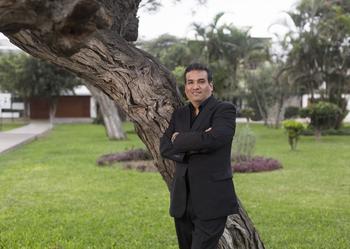Vladimir R. Gil Ramón
Professional Experience (since 2005)
Faculty & Researcher (2009 – current): PUCP’s Environmental Development Master’s Program and Social Science Department at Catholic University of Peru (PUCP); Graduate School Program in Mining Law at Pacific University (2009-2011).
Visiting Faculty (2015 – current) Postgraduate Program on Sustainable Development and Social Inequalities in the Andean Region (TrAndes) at Freie Universität Berlin Lateinamerika-Institut (2016); Visiting Research Fellow at the Central European University, Department of Environmental Sciences & Policy (2015).
Op-Ed Columnist (2014 – current) Al Jazeera English and El Comercio newspaper.
Director (2012-2014): Consortium for the Study of the Andean Climate Change Vulnerability: Conservation Data Center (CDC) & Department of Economics (FEP) at La Molina Agrarian University (UNALM); International Research Institute for Climate & Society (IRI) & the Earth Institute Center for Environmental Sustainability (EICES) at Columbia University
Fulbright Nexus Scholar (2012-13)
General & Scientific Coordinator (2011-14): Consortium for the Study of the Economic Impact of Climate Change in Peru (EIECCP): UNALM FEP & CDC, Practical Action & Global Climate Adaptation Partnership (GCAP)
Associate Research Scientist (2007 – current): Columbia University Department of Ecology, Evolution and Environmental Biology (E3B) (since 2016, Adjunct); The Earth Institute Center for Environmental Sustainability (EICES) (2010-2016, Adjunct) and CIESIN (2007-2009); University of California, Santa Cruz (2011-2013); Pacific University Research Center (CIUP) (2010-2011)
Post-Doctoral Research Fellow, Sustainable Development (2005-2007): The Earth Institute at Columbia University
Education
Yale University
Ph.D., M.A., M.Phil, Ecological-Economic Anthropology, 2005; Environmental Sciences, Coursework from the Master in Environmental Management, School of Forestry and Environmental Studies (FES)
Catholic University of Peru (PUCP)
Licentiate, 1995, and BA, 1993, Social Sciences, minor in Anthropology
Publications
FDA-CDC-FEP-UNALM-IRI Columbia University team. 2014. General Scientific Coordinator and Researcher. [“Study of the Climate Change Vulnerability and Impact Assessment of the Nor Yauyos Cochas Natural Protected Area”] for Ecosystem Based Adaptation. Lima: Inter-institutional collaboration Fundación de Desarrollo Agrario (FDA)-Centro de Datos para la Conservación (CDC)-Facultad de Economía y Planificación (FEP)-Universidad Nacional Agraria La Molina (UNALM) and International Research Institute for Climate and Society (IRI) at Columbia University. https://www.besnet.world/sites/default/files//mediafile/PERU%20VIA%20Study%20%282013%29%20SP%20vs.pdf
Balstad, Roberta; Roly Russell; Vladimir Gil Ramón; and Sabine Marx. 2009. “Adapting to an Uncertain Climate on the Great Plains: Testing Hypotheses on Historical Populations”. In Adger, W. Neil, Irene Lorenzoni, and Karen O'Brien. Adapting to Climate Change: Thresholds, Values and Governance. Cambridge University Press: Cambridge, UK.
Eakin, Hallie, Pedro Wightman, David Hsu, Vladimir Gil Ramón, Eduardo Fuentes-Contreras, Megan Cox, Tracy Hyman, Carlos Pacas, Fernando Borraz, Claudia González, Diego Ponce de León, Daniel M. Kammen. 2014. Information and Communication Technologies (ICTs) and Climate Change Adaptation in Latin America and the Caribbean: A Framework for Action. Climate and Development, Vol. 6.
Bernex, Nicole – Equipo CCAIJO. 1997. [Atlas of the Quispicanchi Province]. Social Science team member. Lima: Centro de Capacitación Artesanal e Industrial Jesús Obrero (CCAIJO) and Applied Geography Center (CIGA) - Catholic University of Peru (PUCP).
Gil Ramón, Vladimir R. “Human Ecology of the Andes.” In Oxford Bibliographies in Ecology. Ed. David
Gibson. New York: Oxford University Press, forthcoming.
_____. 2024. Batallando por recursos andinos: Industrias extractivas, cultura política, y enfrentamientos ambientales en Perú. Lima: Instituto de Estudios Peruanos (IEP). En prensa.
______. 2020. Fighting for Andean Resources: Extractive Industries, Cultural Politics, and Environmental Struggles in Peru. Tucson, AZ: The University of Arizona Press. DOI: 10.2307/j.ctv1220rm3. https://uapress.arizona.edu/book/fighting-for-andean-resources[1]
______. 2017. Cultural and Structural Lessons from Andean Mining Conflicts (working title). Under contract
with The Arizona University Press.
______. 2017. Environmental Impacts of Migration in the Peruvian Amazonia (working title).
CIFOR. Working paper under preparation.
______. 2017. [Methodological Challenges for the Socio-Economic Study of the Climate Change in
Andean Mountain Ecosystems]. Book chapter, in preparation.
______. (Ed.) 2017. The Economic Impact of Climate Change in Peru. Book project.
______ with the collaboration of Carlos A. Arnillas 2014. [The Economic Impact of Climate Change in Peru: Synthesis.] Edited as La economía del cambio climático en el Perú. IDB and CEPAL, eds. Lima: IDB. https://publications.iadb.org/es/la-economia-del-cambio-climatico-en-el-peru
______. 2014. [The need for an integrated national data environmental system]. Op-Ed. El Comercio,
December 1st.
______. 2014. Is environmental deregulation in Peru's best interest? Op-Ed, Al Jazeera English,
August 12.
______. 2010. Review of Ernesto Cabellos and Stephanie Boyd’s film, Tambogrande: Mangos, Murder,
Mining. Visual Anthropology. January, Vol. 23 (1).
______. 2009. “Adaptation Strategies to Climate Change: Societal Impacts of Tropical Andean
Glacier Retreat”. Background paper for De la Torre, Augusto, Pablo Fajnzylber and John
Nash. 2009. Low Carbon, High Growth: Latin American Responses to Climate Change. An Overview.
The World Bank: Washington, D.C.
______. 2009. Aterrizaje minero: Cultura, conflicto, negociaciones y lecciones desde la minería en Ancash, Perú.
[Mining Landing: Culture, Conflict, Negotiations and Lessons from Mining in Ancash, Peru]. Instituto de
Estudios Peruanos: Lima. 22nd best seller of the IEP’s annual catalogue.
______. 2005. Strategies in Local Conflicts with a Transnational Mining Corporation in Peru: The Antamina
Case, 1996-2003. Ph.D. dissertation. Department of Anthropology, Yale University.
______. 2004. Review of Ben Orlove’s book, Lines in the Water. Anthropological Quarterly. Vol. 77, No.1,
Winter.
______. 1999. Roy Rappaport’s Pigs for the Ancestors. Seminar in Socio-Cultural Project, Yale University.
Available at http://classes.yale.edu/02-03/anth500a/projects/project_sites/99_gil/paperpfa.html
______. 1998. [The Agricultural & Natural Resource Property Rights Reform and its Impact on the Rural Social
Organization and Decision-Making Process]. Co-authored with Manuel Glave. Working Paper,
GRADE, Lima.
______. 1998. [Para-ako: Sand and Human] (Film). Applied Sciences University (UPC): Lima.
______. 1996.[Visual Spatial Analysis] (Film) UPC: Lima.
______. 1995. [Adaptation to Agricultural-Climatic Risk in three Communities of the High Andean Plateau].
Licenciate thesis. Department of Social Sciences, Anthropology, PUCP.
______. 1995.[The Endless Feast: Ocobamba’s Carnival] PUCP: Lima. Selected for the Abya-Yala film
festival, Quito.
______. 1994. [Water Management] (Film) PUCP’s Group for Rural Development (GRUPO): Lima.
______ & VAW. 1992. [Music and religion in El Carmen] PUCP: Lima. Selected for the “America and
Andalucía: Encounter of Two Worlds” film festival, Granada.
PUCP’s Applied Geography Research Center (CIGA) & Handcrafted and Industrial Training Center
‘Jesus Worker’ (CCAIJO). 1997. [Atlas of the Quispicanchi Province]. CCAIJO and PUCP: Lima.
Social Science team member.
______ Visual Anthropology Workshop (VAW). 1993. Moray: Inca Laboratory. PUCP: Lima. Selected
for the 20th Margaret Mead Film Festival, New York, 1996. Researcher and script writer
collaborator.
van Geen, Alexander; Carolina Bravo; Vladimir Gil Ramón; Shaky Sherpa & Darby Jack. 2012. Lead
exposure from soil in Peruvian mining towns: a national assessment supported by two
contrasting examples. Bulletin of the World Health Organization. 90: 878–886.

